2 quinces
juice of 1 lemon
water
caster sugar
1. Peel the quinces and cut into chunks, put into a stainless steel (ie, non-reactive, not aluminium) saucepan, just barely cover the fruit with water, adding in the lemon juice, too.
2. Bring to a boil then simmer for one and a quarter hours, then strain the liquid from the fruit overnight. To strain, set up fruit in a colander over a bowl, and cover fruit with a clean cloth (see tips, below).
3. The next day, discard the fruit and measure the strained liquid and add an equal quantity of caster sugar. Bring sugar and liquid slowly to the boil in a non-reactive saucepan, stirring once or twice until the sugar has dissolved. Skim off any foam that rises to the surface as it comes to the boil. Once bubbling, increase heat and boil rapidly for about 10 minutes then test that it has set.
4. Testing for setting: place an entrée plate into the fridge or freezer to make it very cold. Then, to test for setting, place a spoonful of liquid on the plate. Let it sit there a few seconds and push your finger through the middle of the blob of liquid. If the liquid separates into two blobs, and remains in two distinct halves, it has set. If it’s still liquid (and the blobs join together during the test) keep on boiling the mix, and test again 5 or so minutes later. Depending on how much pectin is in the fruit, it could take a while for it to reach setting point.
Once the jelly is set, pour into sterilised jars and seal.
Tips
1. Don’t cook the quinces for too long, as this destroys the natural pectin in the fruit, which is needed for setting jellies and jams.
2. When straining fruit overnight, never press down on the fruit to extract more juice. Just let it drain naturally, giving it plenty of time to drain. If you press down on the fruit there’s a danger the jelly will turn cloudy, and a good quince jelly should be beautifully red and clear. If you don’t have a clean cloth to cover the fruit, use a large plate, but don’t let the plate press down on the fruit itself.
This recipe borrows heavily from Stephanie Alexander’s ‘The Cook’s Companion’ but she uses Seville Oranges in her recipe, and I’m sure that would be lovely. The other part of this recipe (the lemon juice and some of the method) comes from one of my mum’s best old cookbooks ‘Australian Cookery of Today’, published in the 1940s.



